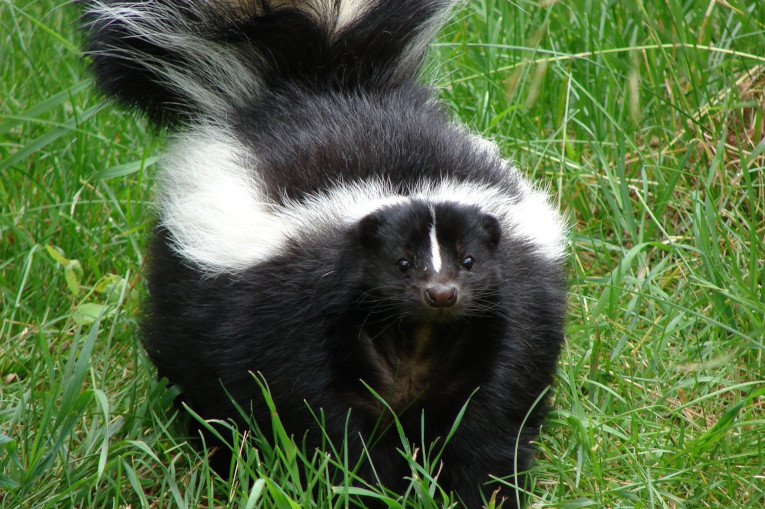On a recent morning I noticed a skunk roaming around my back yard. This surprised me, since over the thirty-one years I have lived here I have many times smelled evidence that a skunk had visited in the night but recall having seen one only once. Skunks are nocturnal, so it didn’t look right that one should be so active in broad daylight.
A few summers back I had discovered that a skunk had been digging up some of my Oriental poppies around a rotting tree stump, and I tried multiple methods of repelling it, finally settling on scattering coyote urine granules among the poppies. The skunk had evidently taken up residence in my yard, making a home under my shed, and I took to calling it “Pepe” after the Looney Tunes character. Over time Pepe joined our family, so to speak, that includes two cats. His digging in the garden subsided, however he did manage to slightly spray one of the cats on two occasions.
The morning I observed him Pepe appeared to have an injured foreleg and tail. Having become attached to him, I immediately called a wildlife rescue organization. Receiving instructions for trapping him I set my have-a-heart trap, hoping he would enter it that night. Days passed and he didn’t. Finally after six days I saw him out in the yard appearing to be in quite bad condition. After he went back into his den I set the trap with a new strategy – placing a dish of wet cat food at the back and a trail of dry cat food leading from the den to the wet food and covering the trap with a beach towel. Because of his worsened condition and the forecast of heavy rain over the next twenty-four hours, I was anxious for Pepe to be captured. He did get into the trap, and later on a volunteer picked him up and carried him to the nearby wildlife rehabilitation center.
Next morning I emailed the center asking how he was doing and in the afternoon received a report from the woman who had delivered him. It was bad. I spent the following morning dwelling on Pepe in my mind as if he were a beloved person in a medical crisis. In such situations we typically focus on the person’s life as we will, so to speak, that it should continue in recovery. For us their lives are complex, intertwining with our own in a variety of ways in the past and present. Such complexity was absent in my concern for Pepe. His was simply a life or, to be more exact, a particular skunk life, so the content of my consciousness was the continuation of that life.
I have previously written about how life, that is, particular lives, extend spatially by forming functional conjunctions with things around them. Such relationships therefore become parts of both the subject’s and the object’s lives. There is likewise extension of life in the fourth dimension – time – and this applies to all “material” objects – they extend their existence from the present into the future. While inanimate objects such as rocks, if left alone, continue their existence in the same form, the existence of organisms is dynamic – they are in constant motion, if only internally. So the temporal extension of their lives involves this continual transformation.
The Enlightenment’s notion of “matter” as the substance of the universe was actually short-lived, for by the mid-nineteenth century it was being replaced with concepts of energy, and this position pretty much prevails today. Running historically alongside such dynamism were a succession of vitalistic ontologies, one of which was that of Henri Bergson. In his 1896 Matter and Memory he asserted that the permanence of “material” things was the repetition of their functions or motions over time. With such repetition the past is literally preserved in the present, making the “matter” of things their pasts as well as their memory. So the temporal extension of things from the present into the future is the continual reproduction of themselves over time.
As it remains unchanged, a rock continually reproduces the same set of functions or essence. Organisms, on the other hand, as I have stated, constantly change as they temporally extend themselves, continually reproducing themselves as they change and therefore preserving the cumulative prior changes. This process gives rise to bodily habits and, at least in humans, memories of particular experiences which can be brought back into consciousness – both functions being literally the recovery of the past in the present.
Present experience of things and interaction with them is always functional conjunction of the subject and the object, and when the experience passes, the object remains functionally embedded, so to speak, in the subject in the form of their past and memory. This fact is especially illustrated in some health crisis with a loved one. A person suffers and grieves for them because the other is literally part of their own life – their pain is one’s own as well. The same applies to things in one’s regular surroundings as exemplified in Chekov’s The Cherry Orchard.
Returning to Pepe, I received a report from the rehab center stating that he was doing OK but was scheduled to have his leg X-rayed and might need some amputation of his tail. I was so relieved to learn that he would survive!
In her book Love, Nature, Magic: Shamanic Journeys into the Heart of My Garden Maria Rodale always concludes her stories of encounters with particular plants and animals with expressions of deep gratitude to them. Likewise, I sincerely thank Pepe for the insight he has given me into the temporal extension of lives and life. Every person, animal, plant and inanimate thing, singly and in functional conjunctions with other things, ultimately the whole universe, continually extends their life from the present into the future. How precious is life, and how great is our mission to serve it!





